Sun-dried Mediterranean fruits blend ancient tradition with practical preservation. You'll need basic tools like drying racks, cheesecloth, and monitoring equipment to get started. First, wash your fruits thoroughly and cut them into uniform pieces, then pretreat with lemon juice to prevent browning. Spread fruits in single layers on elevated racks in direct sunlight, maintaining temperatures above 86°F with humidity below 60%. Your fruits will dry in one to three days, though some may take up to two weeks. Store your finished products in airtight containers for up to six months. This time-honored process opens the door to countless culinary possibilities.
Mediterranean Fruits for Sun-Drying
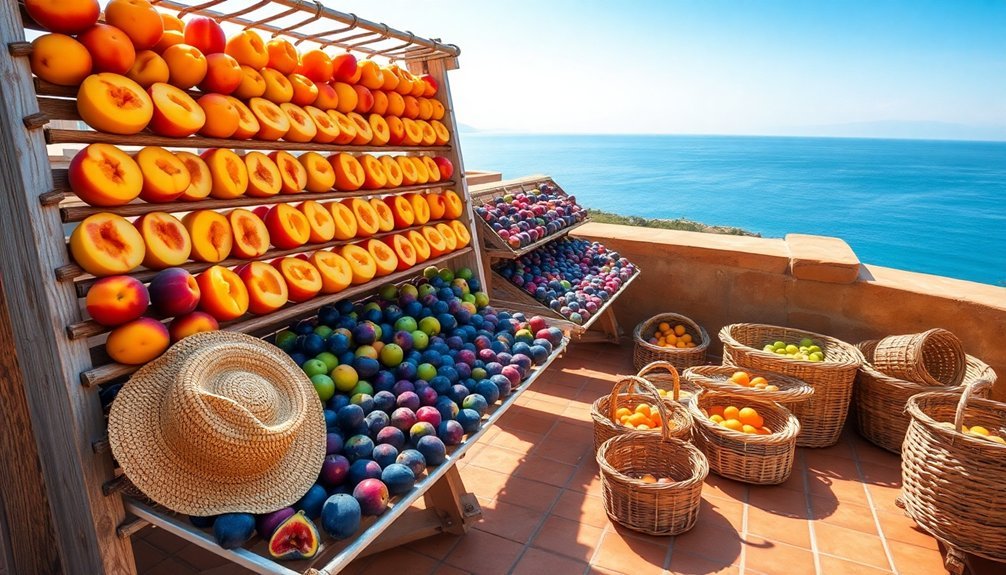
You'll also want to contemplate grapes, which transform into sweet, concentrated raisins through the sun-drying process.
This traditional preservation technique has been utilized since 1700 B.C. to extend the shelf life of fruits.
They're a cornerstone of Mediterranean cuisine and offer great versatility in cooking.
Peaches round out the top choices for sun-drying; you can prepare them in halves or slices, depending on your preference.
When properly dried, they retain their sweet flavor while developing a chewy, satisfying texture that's perfect for snacking or cooking.
Essential Tools and Equipment
When setting up your Mediterranean fruit drying operation, proper equipment forms the foundation for success. You'll need specialized drying racks that promote airflow, protective coverings to shield your fruit, and monitoring tools to guarantee ideal results.
| Equipment Type | Essential Items |
|---|---|
| Drying Surfaces | Cooling racks, plastic trays, screens positioned on concrete or reflective surfaces |
| Protection | Cheesecloth, mesh covers, screening materials for insects and dust |
| Monitoring Tools | Thermometers, weighing scales, humidity meters |
| Preparation Items | Knives, peelers, corers, lemon juice mixture for pretreatment |
Your drying racks should be elevated on blocks to maximize air circulation, and you'll want to space your fruit pieces evenly to guarantee uniform drying. If you're using a solar dryer, make sure it's equipped with glass sides to trap heat and maintain consistent temperatures above 85°F. Modern solar drying technology can reduce traditional drying times from several days to just 24-48 hours.
Don't forget to prepare your protective covering system – you'll need to shield your fruit from birds and insects during the day and protect it from moisture at night. Keep your thermometer handy to monitor temperatures, and always have your scales ready to track the drying progress of your Mediterranean fruits.
Fruit Preparation Steps
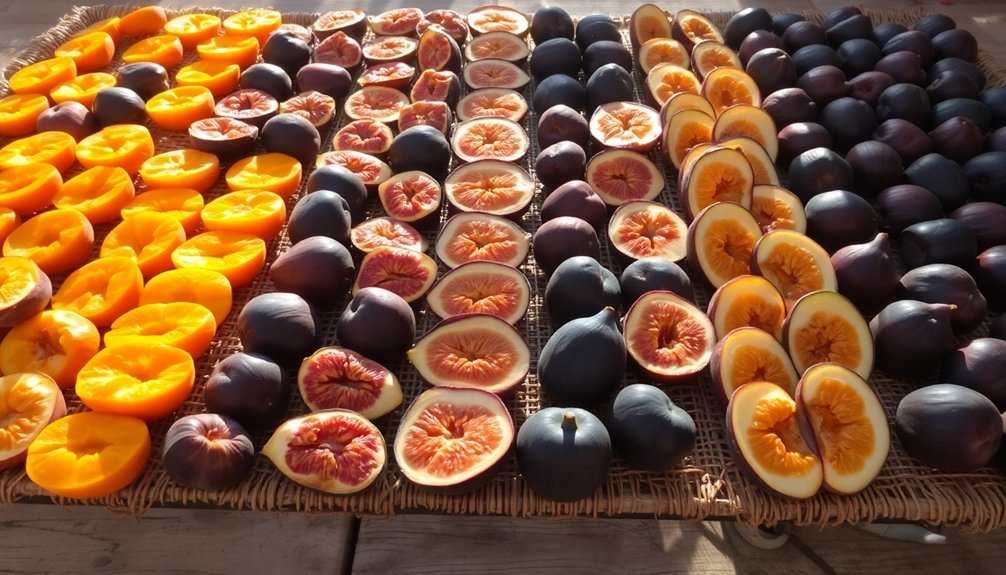
With your equipment ready, proper fruit preparation becomes the next key step in successful Mediterranean fruit drying. You'll need to start by washing your fruits thoroughly under cold water to remove dirt and bacteria, then pat them dry with clean towels. Check carefully for any bad spots or overripe areas that could compromise the drying process. You can also enhance flavor by adding sea salt and herbs before drying.
Next, you'll want to cut your fruits into uniform pieces. For Mediterranean favorites like apricots and plums, cut them in half, while larger fruits like peaches should be peeled and sliced. If you're working with apples or pears, cut them into rings or wedges of consistent thickness.
To prevent browning, you'll need to pretreat your fruit. Mix 1 cup of lemon juice with 4 cups of water and soak your sliced fruits for a few minutes. Alternatively, you can use an ascorbic acid solution or try steam blanching to maintain color and texture.
Finally, arrange your prepared fruit on the drying trays in a single layer, making sure pieces don't touch or overlap. If you're working with particularly sticky fruits, spray your trays with non-stick cooking spray first. Cover the trays with cheesecloth to protect your fruit from insects and dust.
Traditional Drying Methods
Three traditional drying methods have stood the test of time in Mediterranean cultures, with sun drying being the most widely practiced. You'll need temperatures of at least 86°F and humidity below 60% for best results. The process works best on hot, dry, and breezy days when consistent sunlight bathes your drying area.
To start sun drying, you'll want to set up your workspace with clean screens or trays covered in cheesecloth. Spread your fruit in a single layer, making sure pieces don't touch each other. Position your trays in direct sunlight, and don't forget to rotate them periodically for even drying.
For successful sun drying, remember these essential requirements:
- Maintain good air circulation by choosing a breezy location
- Protect fruit with bug screens or fine mesh while allowing airflow
- Monitor closely during the final drying stages, as fruit dries faster
The process typically takes one to three days in ideal conditions, though it might stretch to two weeks if the weather isn't perfect.
While sun drying requires patience and ideal weather conditions, it's particularly well-suited to Mediterranean climates where hot, dry days are common.
Storage and Preservation Techniques
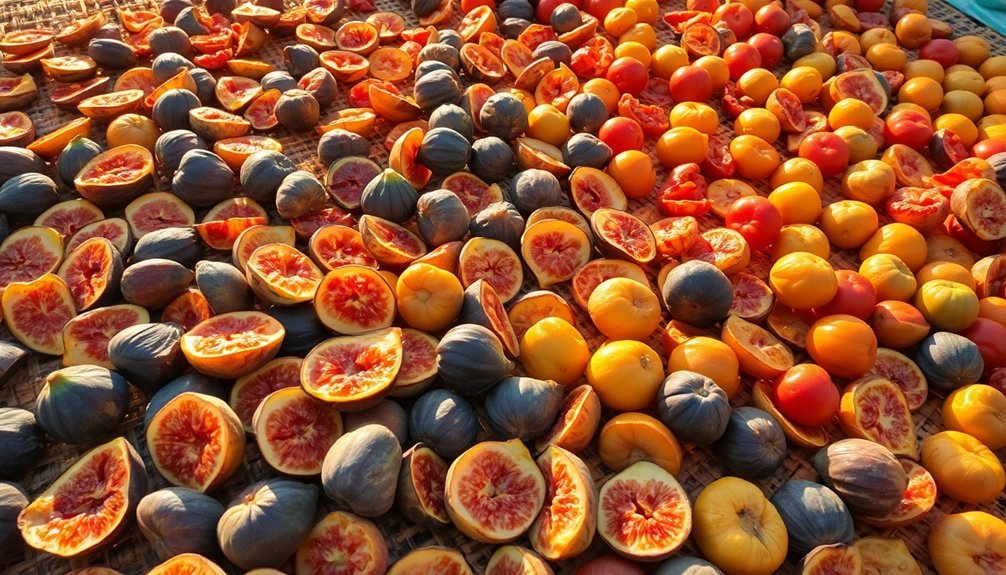
Your dried Mediterranean fruits can last up to six months when you store them properly in airtight glass or plastic containers.
You'll want to keep these containers in a cool, dry place away from direct sunlight and heat sources, checking periodically for any signs of moisture or mold.
For the best results, use O2 absorbers in your storage containers and consider combining preservation methods like heat treatment with vacuum sealing to extend shelf life.
Long-Term Storage Solutions
Successful long-term storage of dried Mediterranean fruits depends on maintaining ideal environmental conditions and using proper preservation methods. You'll need to store your dried fruits in a cool, dry place with temperatures between 40-50°F, away from direct sunlight and strong odors that could contaminate your produce.
For maximum shelf life, implement a multi-layered moisture and oxygen control strategy. Use oxygen absorbers and silica gel packets in your storage containers, and consider vacuum sealing to eliminate air exposure. You can enhance preservation by storing your dried fruits in the refrigerator or freezer, with freezer temperatures maintained at 0°F or below.
- Use airtight containers with both oxygen absorbers and silica gel packets
- Monitor absorbers regularly and replace when they're no longer effective
- Check containers monthly for signs of moisture or mold
Don't skip the essential conditioning period of 4-10 days after drying. During this time, you'll need to stir the fruits daily and monitor for any moisture beads or mold development.
If you notice moisture forming, return the fruits to drying trays immediately. This careful attention to post-drying treatment will guarantee your Mediterranean fruits remain preserved for months to come.
Best Container Practices
Proper container selection and preparation form the foundation of effective fruit preservation. You'll want to choose glass or plastic containers with tight-fitting lids to prevent moisture and air infiltration.
Before using any container, verify it's thoroughly clean and dry, and consider applying a light coating to prevent sticky fruits like figs from adhering to the surface.
During the critical conditioning phase, you'll need to let your dried fruits rest for 4-10 days. Place them loosely in large containers, filling only two-thirds of the space to allow proper air circulation.
You'll need to stir or shake the containers daily to prevent clumping and verify even moisture distribution. If you notice any moisture beads forming, return the fruit to your drying trays immediately.
To protect against unwanted visitors, you should suspend cheesecloth or screens above your fruit during drying, and place table legs in water-filled cans to deter crawling insects.
When storing your containers, keep them in a cool, dry area away from direct sunlight and heat sources. Remember to label each container with the contents and date, and perform regular checks for any signs of spoilage or pest activity.
Health Benefits and Nutrition
When you're choosing sun-dried Mediterranean fruits, you'll benefit from their concentrated nutrient centers, which pack more vitamins and minerals per serving than their fresh counterparts.
You'll find these dried fruits loaded with essential antioxidants like lycopene in tomatoes and beta-carotene in apricots, which help protect your cells from damage.
If you're looking to reduce refined sugar intake, these naturally sweet dried fruits can serve as an excellent alternative while providing sustained energy throughout your day.
Concentrated Nutrient Power Centers
Mediterranean sun-dried fruits pack a powerful nutritional punch, serving as concentrated centers of essential vitamins and minerals. When you consume these dried delicacies, you'll get notably higher amounts of nutrients compared to their fresh counterparts. For instance, dried apricots and figs provide concentrated doses of potassium and iron, while sun-dried citrus fruits maintain their vitamin C content.
The drying process intensifies the nutritional benefits, creating powerhouse sources of:
- Dietary fiber (2-3 times more than fresh fruits)
- Essential minerals like calcium, magnesium, and boron
- Prebiotic compounds that support gut health
You'll find that these concentrated nutrients work together to support your overall health. The high fiber content helps regulate blood glucose levels and promotes digestive health, while the dense mineral content strengthens your bones and supports cardiovascular function.
What's more, these nutrient-rich dried fruits can help prevent various cancers and reduce inflammation in your body. They're particularly beneficial for reproductive health, hormone regulation, and mental wellbeing.
If you're looking to maximize your nutritional intake, incorporating Mediterranean sun-dried fruits into your diet provides a convenient way to access these concentrated nutrients.
Essential Antioxidant Properties
Sun-dried Mediterranean fruits boast remarkable antioxidant properties that surpass their fresh counterparts. The sun-drying process actually increases polyphenol content by 55-75%, making these nutrients more accessible as cell walls break down during drying.
You'll find these concentrated antioxidants particularly effective at reducing cellular oxidative stress, which helps protect against neurodegenerative conditions like Alzheimer's and Parkinson's disease.
When you choose sun-dried fruits like apricots, figs, and tomatoes, you're getting powerful antioxidants that strengthen your immune system and fight cellular aging.
Sun-dried tomatoes are especially rich in lycopene, which combats free radical damage and supports heart health. What's more, you'll benefit from retained minerals like potassium, iron, and calcium, while vitamins A and C levels remain significant, particularly when the produce is pretreated with lemon juice.
To maximize these antioxidant benefits, store your sun-dried fruits in airtight containers in a cool, dark place.
You'll want to condition them for 4-10 days before storage to stabilize moisture content and preserve their antioxidant properties. By avoiding artificial preservatives like sulfites, you'll guarantee you're getting the most natural antioxidant benefits possible.
Natural Sugar Alternative Benefits
Natural sweeteners offer a compelling alternative to refined sugar while delivering impressive health benefits. You'll find that options like monk fruit extract and stevia provide sweetness without raising blood sugar levels, making them ideal for managing weight and blood glucose. Many natural alternatives also pack substantial nutritional benefits that you won't get from refined sugar.
When choosing natural sweeteners, consider these nutrient-rich options:
- Coconut sugar, which contains vitamin C, B vitamins, and antioxidants
- Date sugar and syrup, retaining fiber, minerals, and antioxidants from whole dates
- Blackstrap molasses, rich in iron, B vitamins, potassium, magnesium, and calcium
These alternatives can support your health goals while satisfying your sweet cravings. For instance, yacon syrup contains fructooligosaccharides that won't spike blood sugar and has only one-third the calories of table sugar.
Allulose provides another promising option with just 10% of sugar's calories, though you'll want to moderate intake to avoid digestive issues.
While natural sweeteners like agave nectar are lower on the glycemic index, remember that moderation remains key, as some can still impact triglyceride levels or liver health when consumed excessively.
Cultural Heritage and Traditions
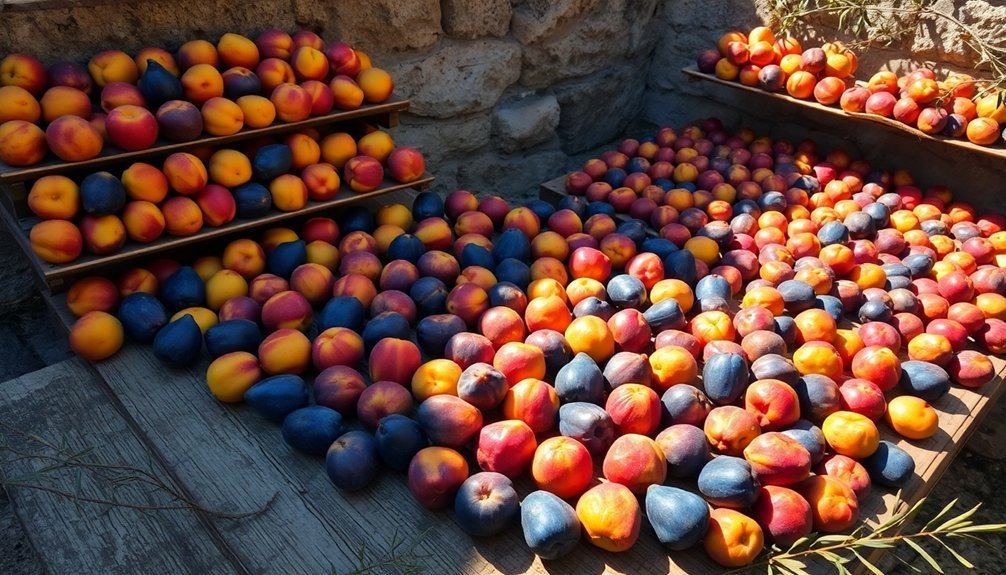
Stretching back over 5,000 years, the art of fruit drying emerged from the fertile lands of ancient Mesopotamia, where dates became one of civilization's earliest preserved foods.
You'll find that this preservation method wasn't just about survival – it transformed dried fruits into valuable trade commodities and essential food reserves during droughts.
As you trace this tradition through ancient Egypt, you'll discover how figs and grapes became central to both daily life and spiritual practices.
The Egyptians perfected the art of sun-drying, creating raisins that served both as offerings to the gods and sustenance for the people.
When you look at Greek and Roman civilizations, you'll see how dried fruits, especially raisins, became integral to athletic performance and religious ceremonies.
The Mediterranean climate proved perfect for this preservation technique, helping it flourish throughout the region.
The Silk Road played a pivotal role in spreading these traditions.
As merchants traveled between East and West, they carried not just dried apricots, figs, and plums, but also the knowledge of drying techniques.
This exchange enriched local cuisines and created lasting culinary connections between distant cultures.
Frequently Asked Questions
Why Do Some Dried Fruits Develop White Spots During Storage?
You'll see white spots on your dried fruits due to three main causes: natural sugar crystallization, mold growth if moisture's present, or waxy substances on the fruit's skin. Each cause needs different attention.
Can I Sun-Dry Fruits in Humid Climates or Coastal Areas?
While you can sun-dry fruits in humid climates, it's challenging and risky. You'll need perfect weather conditions and extra precautions. Consider using a food dehydrator instead for more reliable results in coastal areas.
How Do I Prevent Insects From Contaminating Fruits During Drying?
You'll need to cover your drying fruits with suspended cheesecloth or screens, place drying tables in water-filled cans to block crawling insects, and bring fruits indoors at night to prevent insect contamination.
Which Fruits Should Never Be Sun-Dried Together on Shared Trays?
You shouldn't mix berries with seeds, citrus peels, cranberries, and blueberries on shared trays. Keep them separate to maintain proper texture and flavor. Don't combine papayas with other fruits during drying.
What Causes Some Dried Fruits to Become Overly Tough or Leathery?
You'll get tough, leathery dried fruits when you use temperatures that are too high, which causes cellular collapse. If you don't control humidity well, you'll also get case hardening on the fruit's surface.
In Summary
You've explored a time-honored Mediterranean tradition that keeps summer's bounty alive year-round. By following these sun-drying methods, you'll preserve figs, apricots, grapes, and other fruits just as generations before have done. Whether you're drawn to the sustainable practice, rich cultural heritage, or exceptional nutritional benefits, you're now equipped to create your own naturally dried Mediterranean fruits at home.

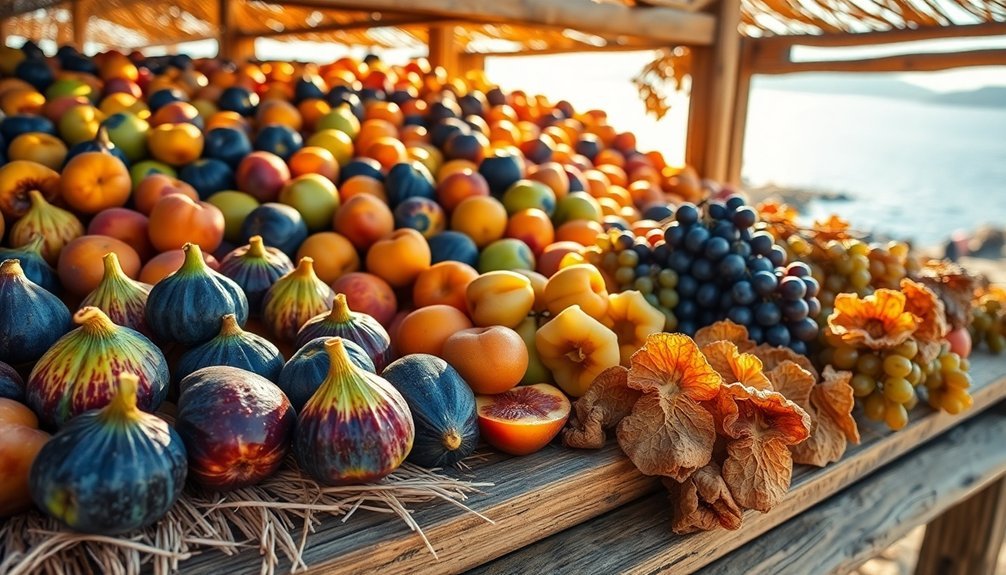



Leave a Reply